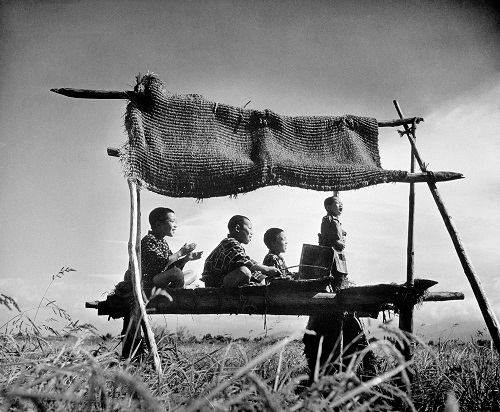By ERIN EMOCLING
TWO years ago on March 11, 2011, a magnitude-9 earthquake followed by a deadly tsunami hit Japan, claiming thousands of lives and destroying homes and other properties.
Most affected by the megadisaster was the Tohoku region in the north-eastern portion of Japan’s largest island of Honshu. The catastrophe caused widespread destruction (including a nuclear accident) in many cities in four of Tohoku’s prefectures, namely: Aomori, Fukushima, Iwate, and Miyagi. (Its two other prefectures, Akita and Yamagata, were not as heavily damaged.)
This 2011 megadisaster, dubbed the Great Eastern Japan Earthquake, is “the chief motivation” for organizing the ongoing photo exhibit “Tohuku– Through the Eyes of Japanese Photographers,” according to Kotaro Iizawa, the exhibit curator and a photography critic,
The exhibit, which marks the second anniversary of the 2011powerful earthquake and tsunami, runs until March 17 at the Gallery XVIII, 3rd Floor, Old Legislative Building of the National Museum in Manila.
On March 9, Iizawa and participating photographer Nao Tsuda will conduct an art talk on Tohoku at the same venue.
Presented by the Japan Foundation, Manila (JFM), the exhibit features 123 photographs of nine Japanese photographers and one photography group, representing the different timelines and aspects of life in the Tohoku region. They are Teisuki Chiba, Ichiro Kojima, Hideo Haga, Naoya Hatakeyama, Meiki Lin, Masatoshi Natio, Hiroshi Oshima, Masaru Tatsuki, Tsuda, and a group of photographers called the Sendai Collection.
“Although many people were made aware of this incredible disaster (2011 earthquake and tsunami)…there was little reporting on the historical and cultural background of the region,” Iizawa said. “This exhibition is intended to fill that gap through the works of photographers.”
Iizawa explained further: “Tohoku has attracted many photographers since …photography was introduced to Japan in the 1850s. After the 1920s, when inexpensive and easily operable cameras became available, the people of Tohoku began taking pictures of their own region. Following the Second World War, there was an increase in the variety and quality of photographs of the Tohoku landscape, people’s lives, and popular events. This exhibition presents a representative selection of such photographs.”
 Each exhibiting photographer has his own style and contribution to the ethnology, life, and landscape of Tohoku from the past and present.
Each exhibiting photographer has his own style and contribution to the ethnology, life, and landscape of Tohoku from the past and present.
Chiba (1917 – 1965), who hailed from Kakunodate, Akita prefecture, was a self-taught photographer who worked as a kimono merchant. His photography reflected the way of living in Akita. He was one of the central figures in Akita photography.
Kojima (1924 – 1964), a son of a merchant who sold toys and photographic supplies, began seriously working as a photographer in 1954. His photographic subjects included the landscapes of Tohoku.
Haga (1921) is the founding member of the Japan Professional Photographers Society, which was set up in 1950. He has taken photographs all over Japan and 101 foreign lands.
Tokyo-born Natio (1938) was given the New Artist Award by the Japan Photo Critics Association in 1966. His work focuses on the folk religions of Tohoku.
Oshima (1944) became known for his Sanhei series, which featured a place in his hometown, where a peasant uprising took place during the Edo period. He is presently a professor in Kyushu Sangyo University.
Hatakeyama (1958) produced a series on the relationship of nature, cities, and photographs. He photographed the destruction in his hometown caused by the Great Eastern Japan Earthquake.
Lin (1969) from Yokosuka, Kanagawa is the manager of Kibo Photographers, a school specializing in photography. He is also the president of Meirin Co., Ltd. and is an instructor at the Club Tourism International, Inc.
Tatsuki (1974) spent almost a decade photographing trucks and drivers. In 2012, he won the 37th Kimura Ihei Memorial Photography Award for the Tohoku photographs he took from 2006 to 2011. He still visits the region to take pictures.
Tsuda (1976) was born in Kobe, Kyogo prefecture. He sees photography as contemporary art and has recently held solo exhibitions in Frankfurt, New York, and Paris. He was the recipient of the Minister of Education Award for New Artist in Fine Arts in 2010.
The Sendai Collection group of photographers is composed of Toru Ito, Shiro Ouchi, Makoto Kotaki, Wataru Matsutani, Hidekazu Katakura, Hisashi Saito, Ryuji Sasaki, and Reiko Anbai. In 2001, Ito formed the group to document ordinary landscapes in Sendai, “which are eroding in the flow of time and about to disappear from memory.”
“TOHOKU – Through the Eyes of Japanese Photographers” is a travelling exhibit that has been to China, Italy, Australia, Malaysia, and India since its inception in March 2012. After the Philippines, “TOHOKU’s” next stop will be the United States from April to May.
